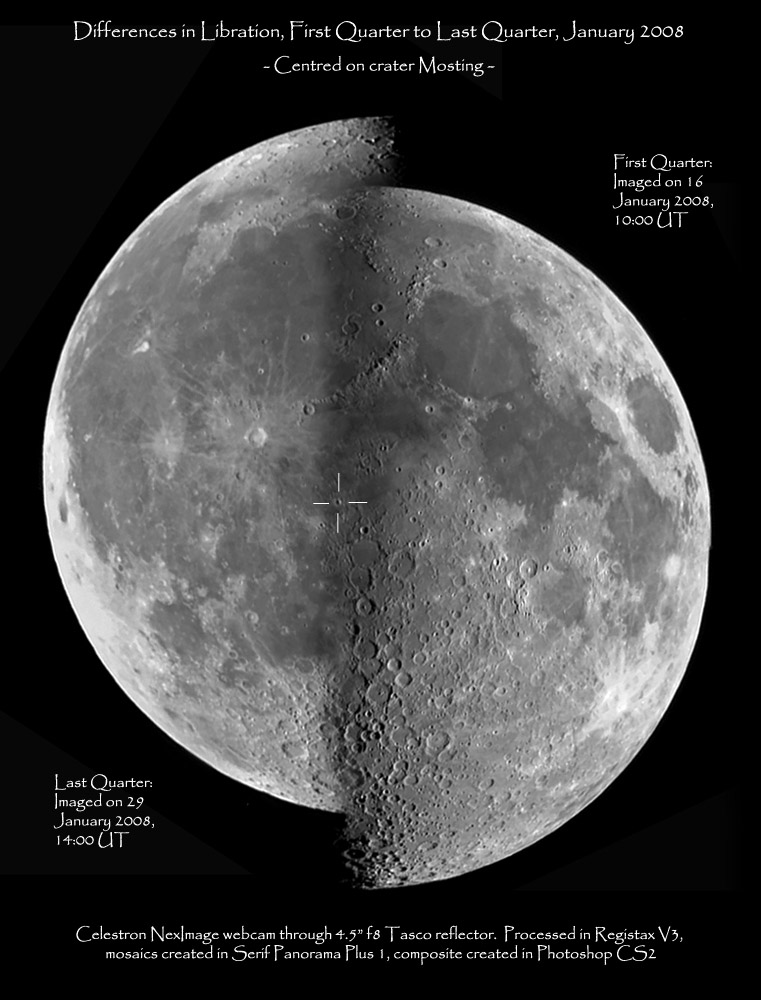Difference between revisions of "LPOD Feb 2, 2008"
(Created page with "<div id="content_view" class="wiki" style="display: block"> =POLAR WANDERING= <br /> LPOD-Feb2-08.jpg<br /> ''image by Rob Kaufman, Bright, Victor...") |
|||
| (2 intermediate revisions by the same user not shown) | |||
| Line 1: | Line 1: | ||
<div id="content_view" class="wiki" style="display: block"> | <div id="content_view" class="wiki" style="display: block"> | ||
=POLAR WANDERING= | =POLAR WANDERING= | ||
| − | <br /> [[Image:LPOD-Feb2-08.jpg|LPOD-Feb2-08.jpg]]<br /> ''image by Rob Kaufman, Bright, Victoria, Australia''<br /> <br /> The LPOD [http://www.lpod.org/coppermine/ Photo Gallery] now has over 3000 images and continues to be a fertile source for LPODs. This is a recent submission that is striking in its ingenious illustration of the effects of [http://www-istp.gsfc.nasa.gov/stargaze/Smoon4.htm libration] in latitude, the monthly tilting of opposite poles of the Moon toward Earth. Normally, [http://the-moon. | + | <br /> [[Image:LPOD-Feb2-08.jpg|LPOD-Feb2-08.jpg]]<br /> ''image by Rob Kaufman, Bright, Victoria, Australia''<br /> <br /> The LPOD [http://www.lpod.org/coppermine/ Photo Gallery] now has over 3000 images and continues to be a fertile source for LPODs. This is a recent submission that is striking in its ingenious illustration of the effects of [http://www-istp.gsfc.nasa.gov/stargaze/Smoon4.htm libration] in latitude, the monthly tilting of opposite poles of the Moon toward Earth. Normally, [http://the-moon.us/wiki/Librations libration] is illustrated by showing how a limb region is tilted into view, but Rob found a new way to dramatically depict the effects of libration. The two quarter phase images were taken over the last 15 days. At first quarter on Jan 16, the southern hemisphere was tipped towards Earth by 6.1°, and two weeks later we could see 6.2° over the northern pole (see [http://aa.usno.navy.mil/data/docs/diskmap.php US Naval Observatory] for libration calculator). Rob has anchored these two images to the 26 km diameter crater Mösting (within four white marks at center of image) which is near the average center of the Moon as seen from Earth. When there is a strong southern libration, as on Jan 16, the apparent center of the Moon is south of Mösting, and on the 29th the apparent center is north of the average position. The extension of each image at top and bottom shows how good librations stretch out the center to pole distance, improving viewing geometry for a whole hemisphere. On both of these dates the libration in longitude was less than a degree so the two images match well at Mösting.<br /> <br /> ''Chuck Wood''<br /> <br /> The image sets a record - I think it is the first LPOD shot with a Tasco telescope! Its not the telescope that makes an LPOD, but the skill and creativity of the imager. <br /> <br /> '''Technical Details'''<br /> 16 & 29 Jan 08. Tasco 4.5" f8 reflector, Celestron NexImage. Mosaics created in Serif Panorama Plus 1; composite created in Photoshop CS2.<br /> <br /> '''Related Links'''<br /> Rükl plate 43 (Mösting)<br /> Rob's other [http://www.lpod.org/coppermine/thumbnails.php?album=lastupby&uid=75 images]<br /> <br /> '''[[LPOD%20Index|Index]] of past LPOD's'''<br /> <br /> <br /> <br /> </div> |
Latest revision as of 13:39, 15 April 2018
POLAR WANDERING

image by Rob Kaufman, Bright, Victoria, Australia
The LPOD Photo Gallery now has over 3000 images and continues to be a fertile source for LPODs. This is a recent submission that is striking in its ingenious illustration of the effects of libration in latitude, the monthly tilting of opposite poles of the Moon toward Earth. Normally, libration is illustrated by showing how a limb region is tilted into view, but Rob found a new way to dramatically depict the effects of libration. The two quarter phase images were taken over the last 15 days. At first quarter on Jan 16, the southern hemisphere was tipped towards Earth by 6.1°, and two weeks later we could see 6.2° over the northern pole (see US Naval Observatory for libration calculator). Rob has anchored these two images to the 26 km diameter crater Mösting (within four white marks at center of image) which is near the average center of the Moon as seen from Earth. When there is a strong southern libration, as on Jan 16, the apparent center of the Moon is south of Mösting, and on the 29th the apparent center is north of the average position. The extension of each image at top and bottom shows how good librations stretch out the center to pole distance, improving viewing geometry for a whole hemisphere. On both of these dates the libration in longitude was less than a degree so the two images match well at Mösting.
Chuck Wood
The image sets a record - I think it is the first LPOD shot with a Tasco telescope! Its not the telescope that makes an LPOD, but the skill and creativity of the imager.
Technical Details
16 & 29 Jan 08. Tasco 4.5" f8 reflector, Celestron NexImage. Mosaics created in Serif Panorama Plus 1; composite created in Photoshop CS2.
Related Links
Rükl plate 43 (Mösting)
Rob's other images
Index of past LPOD's